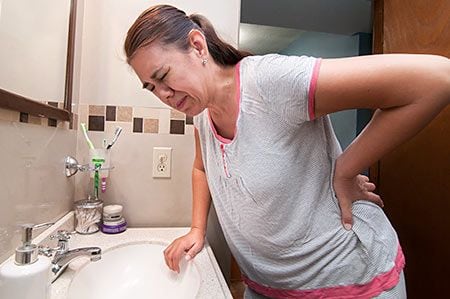
Lower back pain is one of the top reasons that people seek medical care, miss work and are forced to refrain from everyday activities. According to the National Institutes of Health, 8 in 10 adults suffer from low back pain at some point in life. The condition takes an economic toll, with a price tag of $100 billion per year in combined healthcare costs, lost wages and reduced productivity. Fortunately, chiropractic care has provided relief to millions who suffer from this potentially disabling condition. It can often help people avoid more extreme measures like prescription medication or surgery, which carry increased risk of intense side effects.
Causes of Lower Back Pain
There are many reasons for low back pain, including spinal injuries, inflammation or injury of the spinal nerve, pressure on the sciatic nerve, and narrowing of the spinal column. Here are some common lower back problems:
Muscle strain and joint damage — The lower back is more prone to injury than other parts of the spine since it supports a disproportionate amount of weight while allowing us to bend and twist in almost every direction. In addition, factors such as poor muscle stability as a result of a sedentary lifestyle make the lower back more susceptible to muscle sprains, strains and joint damage.
Bulging discs and nerve damage — The spine encases the spinal cord, the main communication system from the brain to the body. The spinal cord has nerve roots that extend outward to send signals to the rest of the body. If a disc bulges, it can put pressure on nerve roots. A more severe form of a bulging disc is a herniated or “slipped” disc. A bulging or slipped disc can cause pain and inflammation as well as numbness and tingling, often extending to the legs or feet if the accompanying nerve root is irritated.
Degenerative conditions — Wear and tear over time can lead to changes in the vertebrae and discs. As we age, discs shrink and provide less cushion between the vertebrae. Cartilage can deteriorate and affect joint motion or pinch the nerve. But good maintenance of spinal and muscle health as well as regular chiropractic visits can help slow or prevent the degeneration process. When signs of degeneration are caught early, there's a much better chance of preserving the health of your spine.
What to Expect at Your First Chiropractic Visit
Many people visit a chiropractor either as a first step in seeking treatment for lower back pain or as a complementary treatment while also receiving standard medical care. During your initial evaluation, the chiropractor will typically take your health history and conduct a physical exam to assess range of motion, check for tenderness, feel for tightness, examine your posture, and check the alignment of your spine.
You will lie on a specially designed adjustment table, and the chiropractor will apply light touches to your spine to determine if any of the joints in your vertebrae have become locked in place. The Doctor of Chiropractic will also determine if you may need x-rays or another type of imaging. Only after a complete exam will a treatment plan be created, and you will be advised how many visits are recommended.
Treatment for Lower Back Pain
Treating lower back pain can involve a variety of therapies, such as adjustment (spinal manipulation). This is a common chiropractic method in which the chiropractor applies specific pressure to segments of the spine with limited motion, either with their hands or with the aid of specialized instruments. A spinal adjustment can help bring your spine into alignment, release locked vertebrae and reduce pain.
Other therapies may include
- specific stretching and strengthening exercises
- therapeutic massage
- spinal decompression
- trigger point therapy
- cold laser therapy
- therapeutic ultrasound
- muscle stimulation
- heat or ice
Why Seek Chiropractic Care for Lower Back Pain?
It's logical to meet lower back problems with the least invasive, most cost-effective treatment, and research supports chiropractic care as effective for treating lower back pain. Here are some conclusions:
- Patients with lower back pain who complemented standard medical care with chiropractic therapy had greater improvement in lower back pain and less use of pain medication than patients who sought standard medical care alone.
- Patients with acute lower back pain who were treated with a variety of chiropractic therapies showed greater improvement in pain and function in the short and medium term than those who were treated with non-chiropractic therapies or those who received no treatment.
The evidence points to chiropractic care as beneficial in treating lower back pain. For relief of lower back pain and return to normal function, chiropractic care can be an excellent first-line treatment option to set you on the path to restored health.
